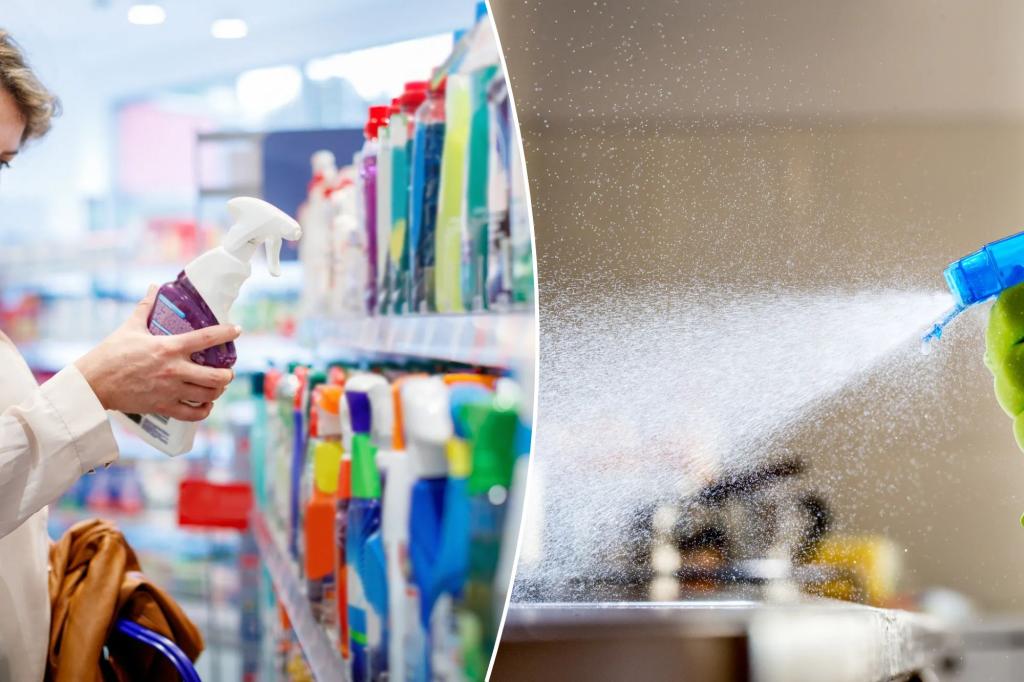Cleanliness is next to godliness — or, perhaps, cancer.
Health experts are warning consumers to avoid everyday products such as certain household cleaners because they contain chemicals linked to cancer, hormone imbalances, respiratory problems and other health problems.
Many of the more popular name brand products have been in households for generations, despite being linked to health problems.
“It’s hard for humans to accept that something I buy in a store can actually harm me and my family or my pets,” Ryan Sullivan, associate professor of chemistry at Carnegie Mellon University, told the Washington Post.
And although many household products are now labeled “green”, “natural” or “unscented”, they may still contain chemicals that are suspected or known to cause health problems.
“The regulations in this country on what you can put in cleaning products and certainly in air fresheners are pretty lax,” Sullivan said.
While some products are safe for most people, young children, pregnant women, people with existing health conditions and households with pets should be careful with the following products.
Air freshener
Aerosols and plug-in air fresheners contain compounds that create artificial fragrances and help them linger in the air for longer.
Most contain volatile organic compounds (VOCs) including formaldehyde, benzene, toluene and xylene, which have been linked to several types of cancer, migraine headaches, asthma attacks, breathing difficulties and nerve problems.
Some also contain hormone disruptors like phthalates, which have “toxic effects at low doses and low concentrations because our natural hormone system is designed to respond to low hormone levels,” Sullivan said.
 Even “green” household products may contain harmful chemicals, experts warn.Getty Images
Even “green” household products may contain harmful chemicals, experts warn.Getty Images
bleach
Household bleach contains sodium hypochlorite in concentrations of up to 5.25%, according to the Cleveland Clinic.
Chlorine bleach liquid and the vapors it emits can irritate the skin, eyes, nose and throat. Direct skin contact can result in dermatitis, while ingestion can cause serious injury to the esophagus and stomach, as well as prolonged nausea and vomiting.
People are warned to never combine bleach, or any product containing bleach, with ammonia or vinegar. The combination can release chloramine gas, which is poisonous in any amount and can cause death.
Oven cleaner
Oven cleaners usually contain alkali, which consists of either sodium hydroxide or potassium hydroxide. Lye is highly corrosive and can burn skin and eyes. It can also cause severe tissue damage – and if swallowed, it can be fatal.
Always wear gloves and eye protection when using oven cleaners that contain alkali, and make sure the work area is well ventilated to avoid inhaling fumes.
There are also non-toxic oven cleaners made without alkali: This may be a safer alternative, but read the label and follow the manufacturer’s recommendations before using the product.
Hand sanitizer
Post-pandemic hand sanitizers are available in almost every home, business, church and school, but most contain high amounts of alcohol — at least 60% in most cases.
That’s far more alcohol than found in high-octane spirits like Wild Turkey 101 Bourbon. Therefore, children who swallow even small amounts of hand sanitizer can experience the effects of alcohol poisoning.
“Hand sanitizers are sometimes packaged in ways that are very appealing to children,” pediatrician Dr. Eva Kubiczek-Love told the Washington Post. “Most of these products come in bright colors, contain eye-catching sparkles or scents that appeal to children.”
Therefore, children should only use hand sanitizer under adult supervision with only small, dime-sized drops on their hands while watching while rubbing until their hands are dry.
 The EPA lists safer household products on its “Safer Choices” website. Getty Images
The EPA lists safer household products on its “Safer Choices” website. Getty Images
Antibacterial cleaner
Antibacterial cleaners usually contain water, fragrance, soap surfactants to break down dirt and pesticides.
The pesticides used in antibacterial cleaners are usually quaternary ammonium or some type of phenolic chemical. This antibacterial cleaner can irritate the eyes and burn the skin and, if accidentally swallowed, the lining of the throat.
mothball
Moth spray contains toxic chemicals, either naphthalene or paradichlorobenzene, according to the Connecticut Department of Public Health. Both chemicals turn to gas when exposed to air, producing the characteristic “moth smell”.
These gases irritate the eyes and lungs and can cause headaches, dizziness and nausea. Moreover, they are both suspected of causing cancer. Naphthalene is considered more toxic because it causes red blood cells to burst, a condition known as hemolytic anemia.
Stay safe with alternatives
“Avoid using air fresheners altogether,” advises the American Lung Association, which lists safer cleaning products like baking soda and diluted vinegar as smart choices.
Reading and following package directions will also help prevent health problems, and keeping cleaning products in pet- and child-proof cabinets will keep them safe.
Experts also advise against mixing products, or pouring one product into another product container, to avoid creating an unstable or dangerous combination.
The Environmental Protection Agency has a comprehensive website of “Safer Choices” household products that contain ingredients that are safer for human health as well as the environment.
Categories: Trending
Source: thtrangdai.edu.vn/en/



